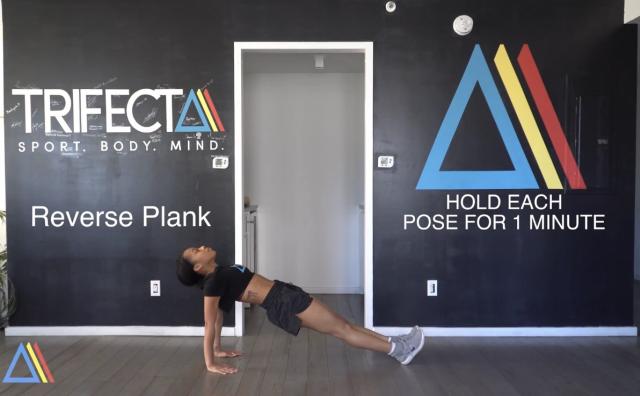![]()
Are planks a form of torture? Possibly. Planks are definitely a perfect example of no pain no gain. They test your core without stressing out your back like some core exercises can do. The other great thing about them is that there are countless variations to planks that you can do to work out muscles other than just your core/abs. For those looking to up your plank routines or to add new challenging bodyweight workouts that will work new muscles, I’ve got some fun plank variations for you.
First, let’s cover the basics. There are 2 standard types of planks: push-up planks and forearm planks. The push-up plank is the one where you hold a plank in a push-up position (hence push-up plank). Similarly, the forearm plank is held while resting on your forearms. You can keep the palms of your hands flat on the floor or hold them together. In both positions form is really important. Some tips on form: Make sure that your shoulders are placed directly above your hands (or elbows if you’re doing forearm planks) so that you don’t put unnecessary stress on your shoulders. Try to engage your core by tightening your belly to your spine. Keep your butt low (try to keep your body a straight line). Keep your head up.
From push-up plank position and forearm plank positions you can do a variety of exercises to get your heart rate up. My go-tos are mountain climbers (with legs pumping straight up and down or knees to opposite elbows), plank jacks, knee-tucks, alternating leg lifts (also called single-leg plank), alternating leg lifts with alternating arm raises (single-arm planks), shoulder touches, switching back and forth from forearm plank to push-up plank on repeat, and finally, hip dips (or twists). And then of course, there are side planks! You can hold those either on your forearms or hand as well. They’re great for targeting your obliques and testing your balance as well. There are also reverse planks which is exactly what it sounds like, facing up toward the sky instead of the ground. Reverse planks are especially good for your lower back, hamstrings, glutes, and arms.
There are so many more variations and exercises for planks beyond the ones listed above, so don’t worry, you won’t ever get bored. More advanced planks usually involve a wider range of movement and demand balance and control, etc., so they might take some time to get used to. Examples: swinging one leg to the opposite side while simultaneously lifting the arm on that side up to the sky (look up Plank Kick Throughs); swinging one leg to the opposite side until your hip touches the floor, returning to plank, then switching to the other leg (single-leg kick through to hip drop). On the other hand, if you want one that’s held in place, try holding a tabletop/quad plank and let me know how that goes.
Plank walk-outs are another way of torturing challenging yourself/other people. If you have something like a towel or sliding disks (or anything that’ll slide along the floor with your weight on it), start in a standing position with the towel under your feet and then walk your hands out into a plank, followed by sliding your legs/feet toward your hands to return to a standing position. Just like an inchworm. Repeat this across the room and you’ll feel the burn. If you want to make things even more exciting, you can add tools like bosu balls, medicine balls, and weights to your planks.
OK. This is the most I’ve ever talked about planks. There’s a reason why they’re so prevalent in my workouts. No matter how advanced your fitness level is, planks will always be a good exercise to do. Never overlook something just because it seems too simple or it’s gotten too easy. Love ’em or hate ’em, planks are worth every second that you hold ’em.


